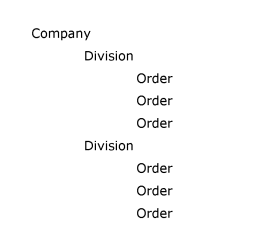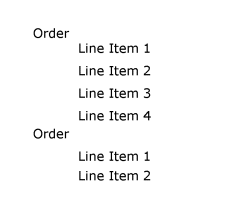Things to Watch Out For
Relationships between business objects are purely visual and may be only vaguely conceptual. It is important to understand that the object relationship feature is not designed to be a data or database modeling facility.
Creating relationships based on the database design can lead to common errors you should try to avoid:
Starting Too High
Sometimes designers structure the trees like database table structures, but start too high in the structure forcing the end-user to drill-down too many levels. For example, they might structure a tree like this to reflect DBMS table relationships:

If the end-users are not really concerned with the Company and Division level then their presence in the tree makes Order navigation needlessly complex.
In a situation like this the Company and Division selection should be done by the filter and no tree structure. A simple list of orders would be much more appropriate and quicker for end-users to understand and use:

Sometimes designers again use a database structure and go too low in the structure and break up the information into needlessly small fragments. For example, they might structure a tree like this:

This structure forces users to manipulate line items one by one, when working with all the line items in an order would be more efficient. So a simple list of orders orders would be much more effective for end-users to understand and use:

With a command tab for items that allow all the line items associated with the order to be viewed and manipulated in, for example, a single grid would probably be more appropriate.